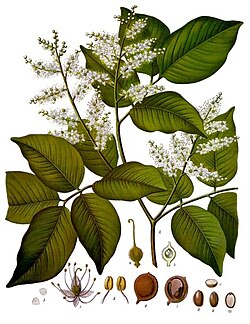| Copaifera | |
|---|---|
 | |
| Copaifera officinalis | |
| Scientific classification | |
| Kingdom: | Plantae |
| Clade: | Tracheophytes |
| Clade: | Angiosperms |
| Clade: | Eudicots |
| Clade: | Rosids |
| Order: | Fabales |
| Family: | Fabaceae |
| Subfamily: | Detarioideae |
| Tribe: | Detarieae |
| Genus: | Copaifera L. (1762) |
| Species [1] | |
40 see text | |
| Synonyms | |
| |
Copaifera is a genus of tropical plants in the legume family Fabaceae. [2] It includes 40 species native to the tropical Americas (Nicaragua to northeastern Argentina), west and central tropical Africa, and Borneo. [1]
Contents
The scientific name means "copal-bearer" (or more accurately, copaiba -bearer), since economically important resins and essential oils can be acquired from them. They are also important for production of biodiesel and wood, especially Copaifera langsdorffii . Other species are threatened, mainly by deforestation.
Oil extracts from the genus are of particular interest as a source of antimycobacterial agents. [3]